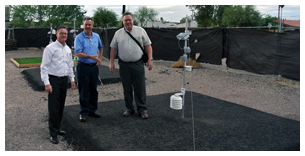| Monday, December 03, 2012 | ||
 |
 |
 |
| Past Issues | www.texasasphalt.org | Printer-Friendly | Subscribe | Advertise |
NAPA: Unintended Consequences of Reflective Pavements
We would like to thank our partners at The National Asphalt Pavement Association for the following article: A recent study from the Jacob School of Engineering at University of California, San Diego, raises questions about relying on more reflective pavements to mitigate the urban heat island (UHI) effect. Several green construction ratings systems suggest using highly reflective pavements to address UHI, but the UCSD study finds that such pavements can increase energy used to cool surrounding buildings. For example, the study states that "Increasing pavement solar reflectivity from 0.1 to 0.5 increased annual cooling loads up to 11 percent ... for a four story office building ... in Phoenix, Ariz." Click here for a synopsis of the study.  Dr. Howard Marks, NAPA Vice President for Environmental Affairs said, "The study results confirm our intuition that highly reflective pavements might not be a good strategy for reducing UHI effects." Marks noted that other researchers are observing similar findings, indicating that dark pavements are an acceptable green construction strategy in warm climates. "Our next step," Marks stated, "is to collect all these research findings and make the case to green construction code developers and promoters that reflective pavements are not a viable strategy to reduce UHI." For more information, contact Dr. Howard Marks at hmarks@asphaltpavement.org. Dr. Howard Marks, NAPA Vice President for Environmental Affairs said, "The study results confirm our intuition that highly reflective pavements might not be a good strategy for reducing UHI effects." Marks noted that other researchers are observing similar findings, indicating that dark pavements are an acceptable green construction strategy in warm climates. "Our next step," Marks stated, "is to collect all these research findings and make the case to green construction code developers and promoters that reflective pavements are not a viable strategy to reduce UHI." For more information, contact Dr. Howard Marks at hmarks@asphaltpavement.org. |
Asphalt: Smooth | Durable | Quiet | Safe






